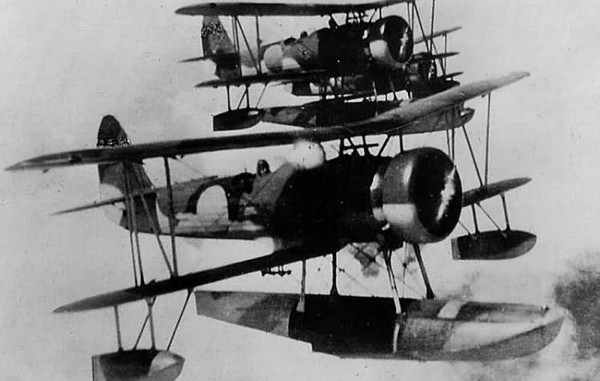
Designed as a replacement for the E4N Type 90, the Nakajima E8N was a derivative of this older plane but featured a more powerful engine, slimmer wings, and a taller tail. A prototype was entered into competitive trials against models from Aichi and Kawanishi, but the Nakajima was accepted and order into production.
The Type 95 was a biplane with a large central float, supported by outrigger floats under the wings. The crew consisted of a pilot and a radioman/observer. The pilot could operate a pair of 7.7mm machine guns, or drop a pair of 30kg bombs which were mounted under the wings.
The Type 95 equipped most Japanese cruisers and battleships during the China Incident, and saw a diverse range of uses aside from standard reconnaissance role. The Type 95 was used as a dive bomber to support troops in the field, as an artillery observer, and as an auxiliary fighter. It was due to its relative success in the latter role that the IJN began to look seriously at seaplane fighters as viable for forward operations, which led to designs like the A6M2-N “Rufe” and the N1K “Rex” floatplane fighters.
A single Type 95 was acquired by Germany for operations on the raider Orion, and transferred to that ship in February 1941.
A number of Type 95s were still in use when the US entered the war, but these were mainly with second-echelon warships. E8Ns were assigned the Allied reporting name “Dave”. The type was gradually replaced by the much more modern E13A Type 0 “Jake” and the F1M Type 1 “Pete”.
| Nakajima E8N2 Type 95 "Dave" | |
| Role | Reconnaissance Seaplane |
| Crew | 2: Pilot. radioman |
| Powerplant | Nakajima Kotobuki 2 Kai 2 (630hp) |
| Speed (cruise/max) | 115mph / 186mph |
| Ceiling | 23,850ft |
| Range | 558 miles |
| Armament | 2x 7.7mm machine guns |
| Ordnance | 60kg bombs |
| Dimensions (L/W/H) | 37ft 1in / 47ft 7in / 15ft 9in |
| Weight (empty/max) | 2,904lb / 4,180lb |




Leave a Reply